The biggest variable present is myself. I think that needs to be acknowledged prior to any serious discussion about cutting edge barrel technology. Taking everything at face value would be a disservice to the ability of the Straight Jacket and the fine barrel makers at Criterion Barrels Inc. Some things could be improved, some things can’t be helped, and some variables may go unseen by me and seen by you. Let me further preface this by saying this has been a journey… and a not so simple one at that.
My first trip to the range with the SJ system was a simple compare and contrast between the Criterion barrel before, and after SJ application. The barrel started life as a tapered profile .223 wylde match chrome lined barrel which was shared with me for review by the folks at Criterion. David Bailey of Teludyne Tech, maker of the SJ system, noted my post on the “Data Driven AR15” and graciously decided to apply the SJ barrel for inclusion and review on the “Data Driven” article.
The compare and contrast used a standardized target and four unique loads I have previously worked up. Present were two powders with very different burn rates, and several different projectile products as well as one factory loading from Hornady.
Three hand-loads were used:
Hornady 55 Vmax / 25 Gr Varget CCI 400 primer LC case
Sierra 60 Varminter / BLANK CCI 400 primer LC case
Hornady 75 HPBT / 24 grains Varget CCI 400 primer LC case
The factory load was Hornady SP 55 grain
The test loads were shot in a set order both range sessions and each group was shot at a natural cadence, back to back slow fire with no cool down between each ten shot groups.
My Criterion test was preformed on a 75 degree spring evening from a shooting bench with gun rest in a very relaxed setting. I was using a 8x scope with a 0.5 minute center dot. The target was a printout target made for ease of use with OnTarget software. Unfortunately when I got to the range with the Criterion, I noted how faded my target looked. It was somewhat difficult to center my 0.5 minute center dot on the 1 MOA circle due to how faded it was. Never-the-less I shot the groups and stored the results on a poster board for follow-up.
I send off the Criterion to Teludyne Tech and got it back around 2 weeks later. I was excited to hit the range, however I noted that the change in conditions were quite extreme. I was shooting on a 95 degree day, with 80 percent humidity, and with a mosquito problem. It was a miserable day to test, but I wanted to proceed anyway being as how home responsibilities keep me quite busy. I shot using the same target (which, at this point, I feel was a limiting factor in my accuracy evaluation pre-and post jacket) which… again was difficult to use. Even though I disliked the target, I had to keep everything the same. I shot from a stable prone position on bipod and rear bag.
After evaluating the before and after, I felt like I wasn’t shooting up to the capability of the SJ system and likely my handloads were not performing to the level capable of the STJ or vanilla Criterion. Let’s discuss some of the variables.
Variables:
Extreme heat shift / shooter comfort
Insects
Application of SJ system
Shot from bench at 1st range session, shot from bipod prone at 2nd range session
What remained the same:
Ammunition, rifle, trigger, optic.
Difficult / faded target.
So let’s consider for a moment that the accuracy results for both the SJ system and Criterion were limited by my target choice. At the time I did not feel the test captured the accuracy potential of the STJ or the Criterion barrel… but the data always has something to show. Let’s look for patterns:
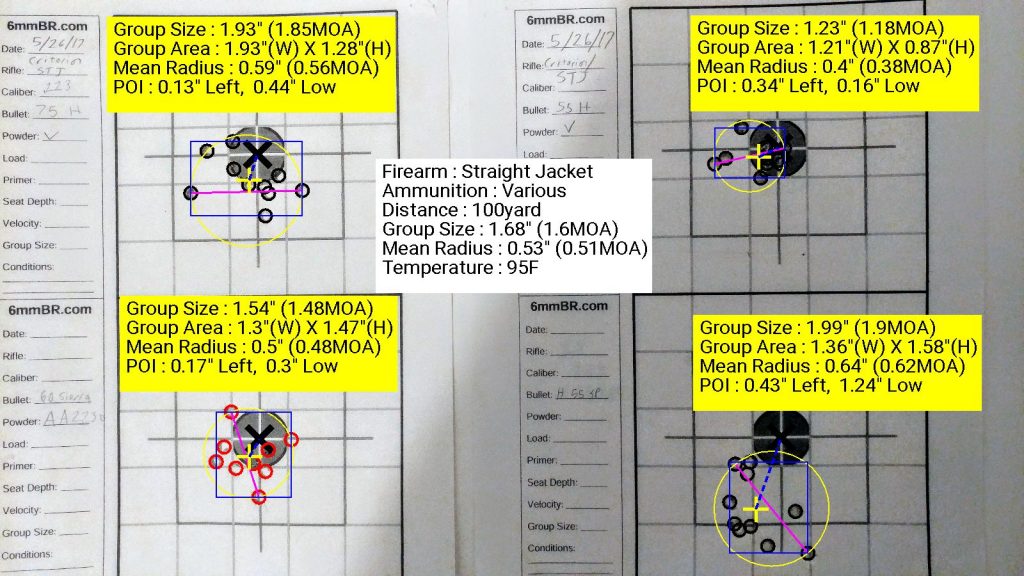
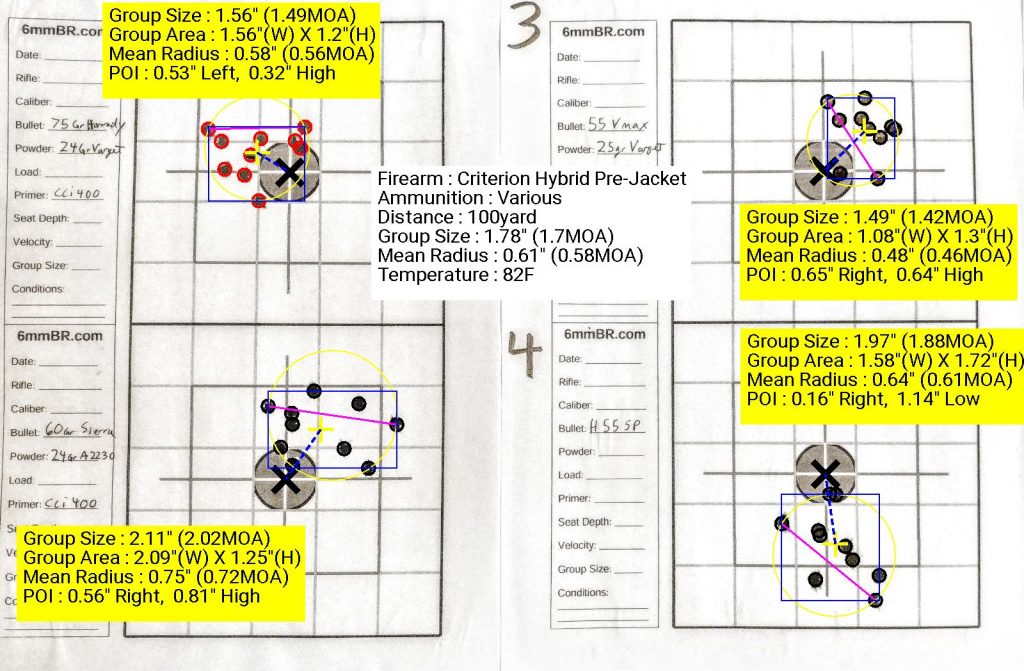
So a 1/10th of a point increase in accuracy for extreme spread, and mean radius average from .58 to .51 MOA. Again, as you will see a bit further down the article, the Straight Jacket was capable of far more accuracy than the above test showed. I came to the conclusion that my loads were not as accurate as I thought… Mainly due to the Hornady V-Max. 7 rounds of 10 were touching with the Straight Jacket. The precision of this load increased dramatically from the vanilla Criterion Hybrid. This lead me on a journey to refine my handloads to make sure I wasn’t masking the Straight Jacket’s performance.
Upon further study of the targets, another point stood out to me.
See the Criterion? Each loading naturally has a different point of impact. We expect a shift in point of impact with each new load due to barrel “harmonics”. When the primer ignites, and 50k psi of heat and pressure surges through the barrel… it twist, it wiggles, and it moves. Since each load/powder and pressure gradient is unique, each load will cause the barrel to move in subtly different ways and thus your point of impact can shift from load to load. With each load having its own effect on the barrel, the barrel will whip and release the projectile at a different X, Y axis.
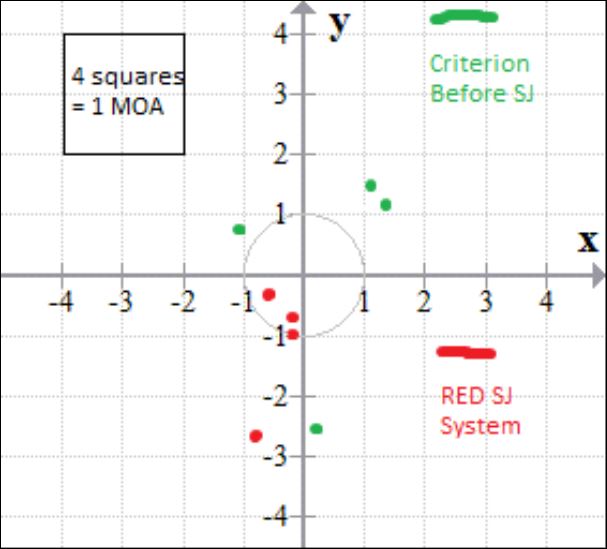
The Straight Jacket (red) seemed to normalize group centers to the bottom left of the X-Y axis, overall showing much less extreme spread of the 4 different loads. The Criterion (green) before jacket application, with the same loads, threw rounds above, below, to the left and right of the XY center.
The Straight Jacket system appeared to greatly reduced POI shift from load to load. On Target software revealed the statistical center of each shot group, and the Straight Jacket equipped Criterion barrel saw a POI shift from the 3 hand-loads of LESS THAN .25 MOA FROM LOAD TO LOAD. This effectively means that three of my hand loads could share the same zero after jacket application. Before the jacket, each load would need its own unique zero. Indeed, in my journal I have many loads marked with the zero necessary to adjust my optics, but none of the groups are as close as together as the Straight Jacket. The Hornady factory load was low for both barrels leading me to believe the extreme spread was to blame for the lower than normal group center. The Hornady had the greatest ES, SD, and pushed 2MOA for precision… hardly match material. Even with the poor performance of the Hornady load, it too had a left bias after jacket application on the Y axis which aligns it closer with the other hand loads.
I have another target which I will publish in the follow-up article which exhibits this same behavior with another set of loads. Most loads are within 1/2 to 3/4 a minute to the other loads on the X-Y Axis. It’s a very unique aspect of the Straight Jacket and I will publish more on this in the future.
Raw Precision Test: “Every Shot is a Cold Bore Shot”
The above quote is one of the many fantastic claims made by Teludyne Tech. A cold bore shot is the term to note both precision and accuracy from the first few shots of the bore. As round after round heats up the barrel, the harmonics change and both POI and rifle precision change. Typically a hot barrel will both open up in group size, and show a POI shift.
The first problem to tackle, before testing the “Cold Bore” claim, was ensuring my loads were up to snuff. As I mentioned, I looked at my loads and pursued the most accuracy possible.
I shot many bullets and powders. This is the primary reason this article took so long to publish. I tried load after load to see if I could get the bullets touching like the V-Max *hinted* it could do. Some were a bust, and others… just wow. I just wanted to see if this barrel could shoot Sub-MOA Ten round groups.
Time to see what the Straight Jacket could do.
I worked up 55 grain VMAX load the same way as before: 25 grains of varget, cci 400, and the 55 Vmax. New optic, new target, no biting mosquitos, same barrel:
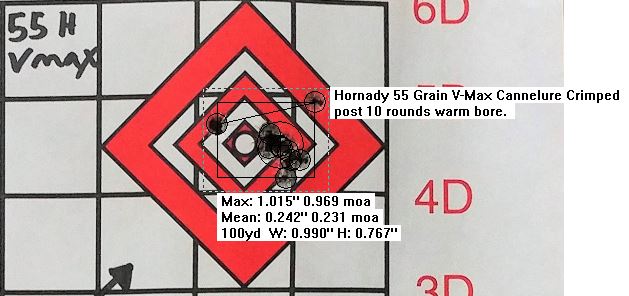
If we tossed the two “outliers” the 8 round group would have measured .43 MOA and a mean of 0.134. Imagine if the Straight Jacket was in a machine rest! 80 % of the rounds were touching!
The results were impressive. Again, I feel like I am a big variable. Try as I might, I am not a machine rest… but as far as usable accuracy, the 55 VMAX and Straight Jacket was a devastatingly precise load. I may be holding the rifle back with my 10x optic.
A quick note: 10 round groups are utilized to give us a large confidence factor. Traditionally, many shooters measured the distance between the two furthest shots, but this is a poor indicator of load performance. In the above group as example, to ignore the tiny group in the middle is to ignore 80% of the data… The two “flyers” could have been me, or maybe an inconsistent loading, but the bulk of the group indicates that something is consistently precise from both shooter, load, and barrel. Mean radius is a better indicator of rifle precision, and a random flyer will not have as large of an impact on the mean if every other shot is precise.
I worked up another load… this time a 52 ELD from Hornady. This projectile was loaded to magazine length and also loaded with 25 grains of Varget. Upon testing, it too showed devastating accuracy. 10 round groups were simply phenomenal. What’s interesting with this load, is that the second photo below was a hot gun. Typically, we don’t want to run 50+ rounds back to back before accuracy testing. We don’t want to accuracy test with the hand-guards too hot to hold. With the Straight Jacket, it didn’t seem to matter.
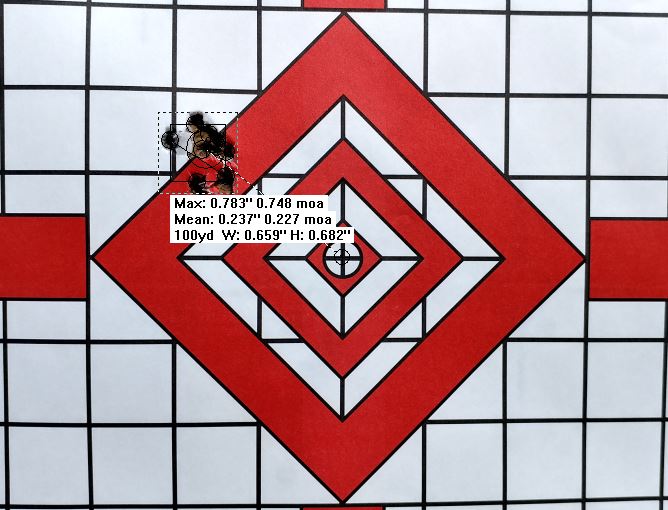
July 5th, 2017 Cold bore target, raw accuracy testing, 10 round group. 52 Hornady ELD Match with 25 grains of Varget.
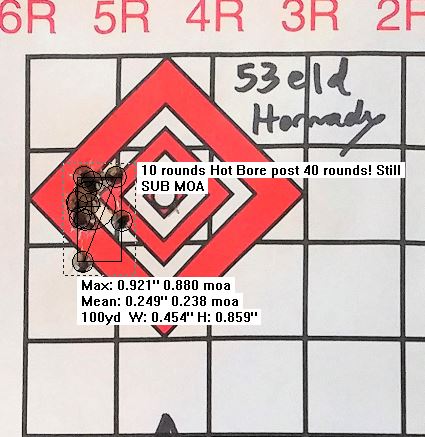
Aug 21, 2017 Hornady ELD Match, rounds 41-50… hand-guard too hot to hold, still sub MOA. If you don’t count the bottom “flyer” then the 9 round group extreme spread is .56 MOA with a mean of .2 MOA. The gun was too hot to handle and the precision remained unchanged.
The 52 ELD’s precision remained unchanged regardless of the bore was hot or cold. The above group was at the tail end of a torture test I did, and with 40 rounds through a hot gun before the 52 ELD’s turn to shoot… I would say that the bore was nice and hot, but the Straight Jacket kept almost all the rounds touching. At the very minimum, it seems the Straight Jacket doesn’t lose precision related to long slow fire strings.
The rifle groups like its cold, even when it’s hot, just as advertised.
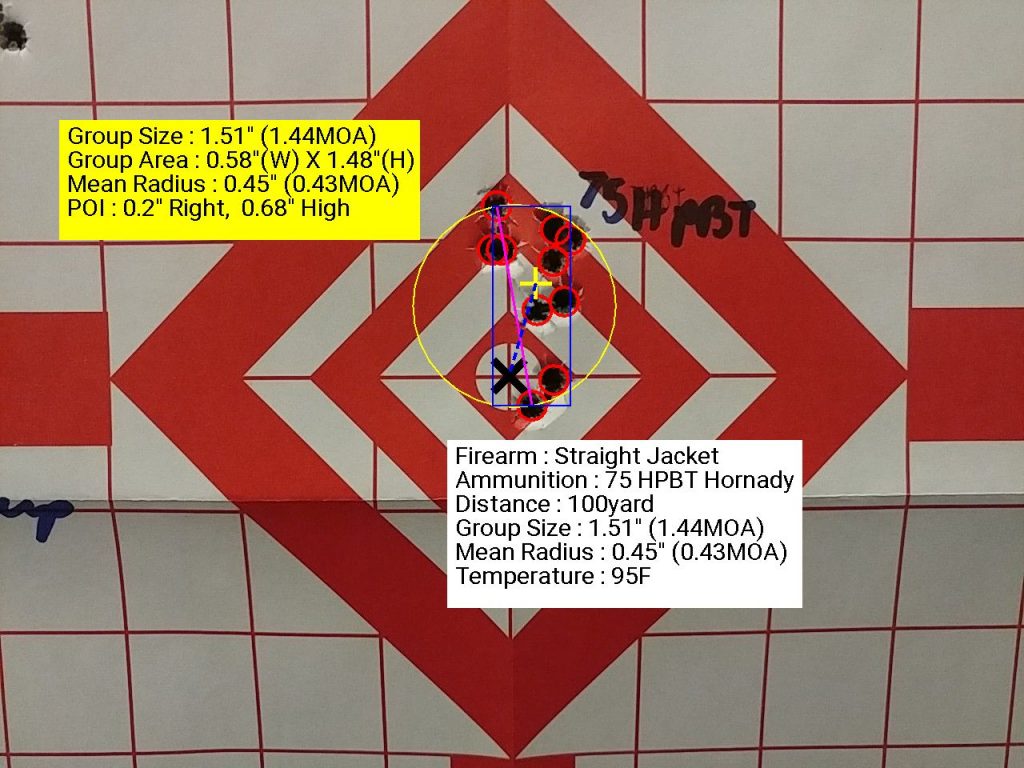
I have shot many loads, and my pet load hasn’t shown me “every round touching” accuracy… before I retire my 75 HPBT I want to shoot it with higher magnification and on a cooler day. Fall is coming. Thank God.
Does that mean I shot laser beams every time I took out the rifle? No. My best groups with V-Max and ELD were shot in the early morning, between 7-9 am, while I was covered head to toe in OFF, and with no wind. On a 95 degree afternoon, with sweat pouring off me, 5-10 mph winds, bugs in my face… I wasn’t able to group laser beams like above. South Texas is hot. Those same rounds would open up… so it’s clear that the shooter is a big factor here, so keep that in mind. Lock this gun in a machine rest and I expect it could do even better.
If you and your load are up to it, the Straight Jacket can shoot lasers.
POI Shift:
What about point of impact shift? As traditional barrels heat up, it’s not uncommon to see the POI shift or “walk” as the group moves in another direction. To model this I used a simple method. First was simply shooting two separate targets to check POI shift and superimposing them on another. Then I marked the center of the first group and measured the POI shift for the second group off the shot center with a ballistic program.
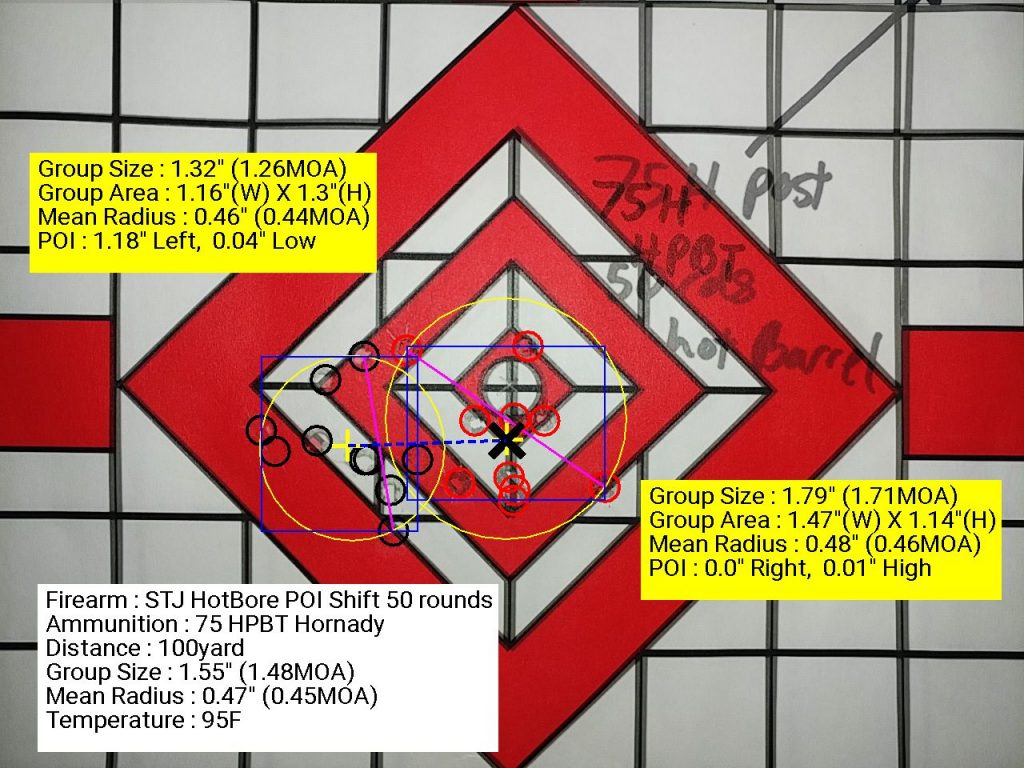
Hot bore. 50 rounds slow fire. Two targets superimposed with camera software. Rounds 1-10 on the right (in red) and then rounds 51-60 (in black) revealed a 1.18 inch shift left and a negligible vertical shift.
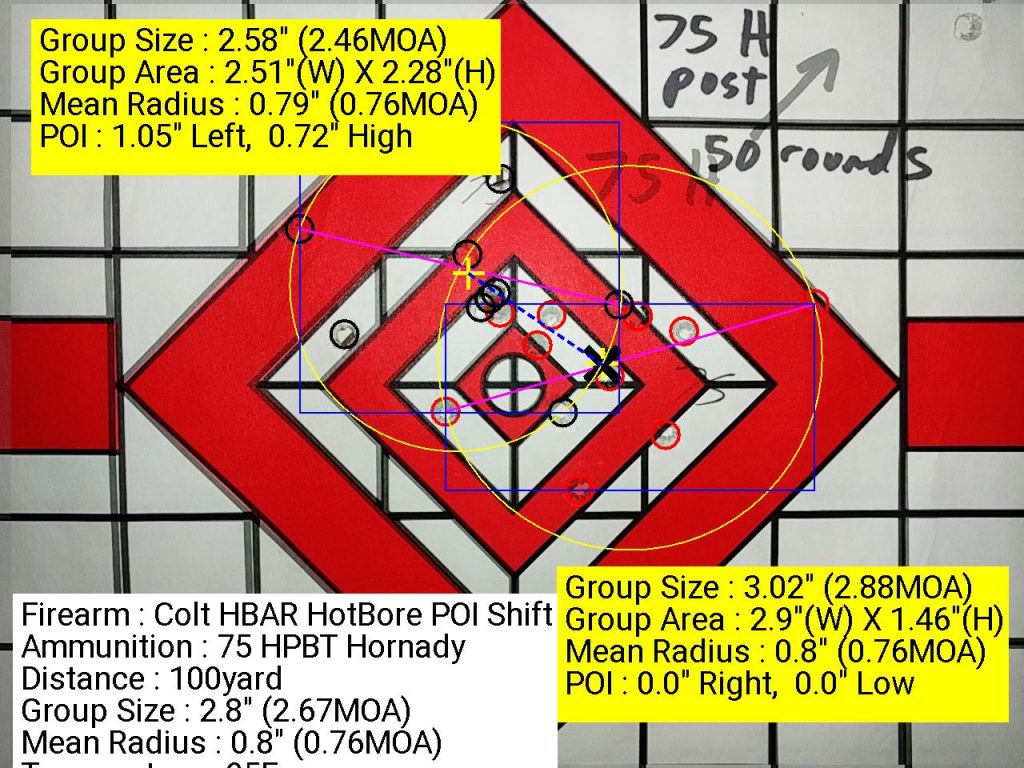
Control: Colt HBAR Hot Bore: two targets superimposed, 50 rounds slow fire, POI shift measured from 1st group center (in red) to second group center (in black).
So with both the Straight Jacket and HBAR we see a hot gun POI shift. With the SJ we have about a 1 inch shift left after 50 rounds slow fire, and with the Colt HBAR a one inch shift left and 3/4 inch upwards drift. I don’t think the shift lies solely on the barrel in either instance, as the M4E1 (Criterion / Straight Jacket) and Sabre Defense upper (Colt HBAR) are two completely different systems. The Sabre Defense receiver was lapped and bedded with Rock-Set prior to torquing the barrel to 65 ft lbs and is not free floated. I am not sure of the fitment of the M4E1 + Straight Jacket, but I will uninstall and re-test by bedding the Criterion / Straight Jacket as well. Perhaps this will diminish some POI shift? We will find out.
Let’s examine another with a 30 round mag dump:
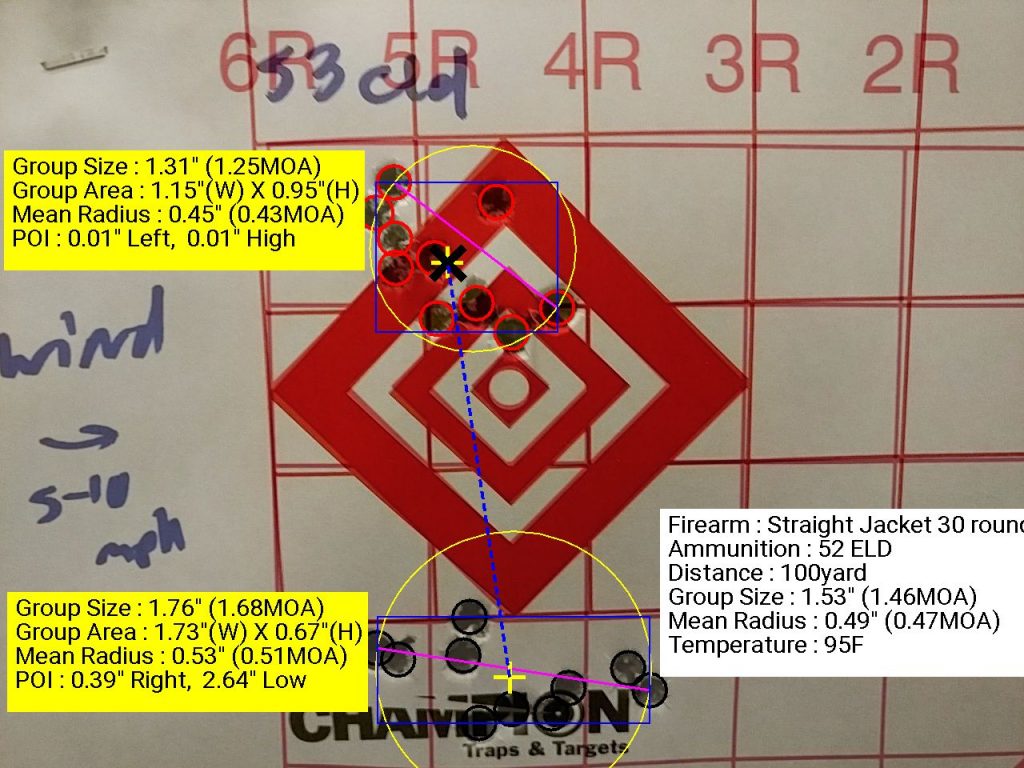
Straight Jacket: Cold bore on top followed by a 30 round mag dump, then back to shoot slow fire groups on bottom.
The above is a 10 round slow fire group, followed by a 30 round magazine dump, then followed by another 10 round slow fire group with 52 ELD match. I shot this test on a hot, crappy day. Wind and heat affected shooter performance here no doubt, but overall the trend down is obvious. Following a rapid “as fast as I could” magazine dump, the Straight Jacket put rounds 2.6 inches low. Don’t focus on the group size for this exercise, as it is the same laser beam ammo (52 ELD) that you saw further up… what we are looking for is a POI shift and we definitely have one. The gun and receiver became warm, and I still can’t help but wonder how much is the Straight Jacket and how much is the receiver.
I say this because the M4E1 acts as a giant heat sink itself. The barrel nut threads internally into a receiver extension which is a massive hunk of aluminum. Heat transfers into aluminum rapidly, and I believe the unique configuration of the M4E1 allows it to absorb heat very quickly. I will disassemble, bed, and re-assemble to decrease the receivers possible effects on further POI shift testing.

The M4E1 will be isolated as much as possible for future POI shift testing.
Group Torture:
I wanted to pit the Straight Jacket vs a control to see how well the Straight Jacket / Criterion shot against another thick chrome lined barrel. I shot the Colt HBAR as a control. I used the same lower and optic. Since the HBAR was not free-floated, I used a mechanical rest and positioned the rest on the delta ring to minimize the influence of the rest on the barrel. I did not touch or rest the barrel on any surface other than the delta ring and rear of the handguards. Again I realize the limitations without a free float rail, but c’est la vie. The HBAR should be a “fair” equivalent to the STJ / Criterion. Both are chrome lined, and the thick profile of the HBAR is more conducive to accuracy and consistency than a skinny gov’t profile barrel. I will re-visit this test in the future as I intend to free float the Colt.
My setup was simple. Slow fire back to back magazines shot at a natural cadence. I shot my primary load first with a cold bore, and then moved clockwise around each target to evaluate the accuracy under heat. My second load was the Hornady 55 VMAX with cannelure, third load was M193 ball, fourth was factory Hornady 62 grain black, and then I finished with a hot as hell bore and my accuracy control: 52 ELD match.
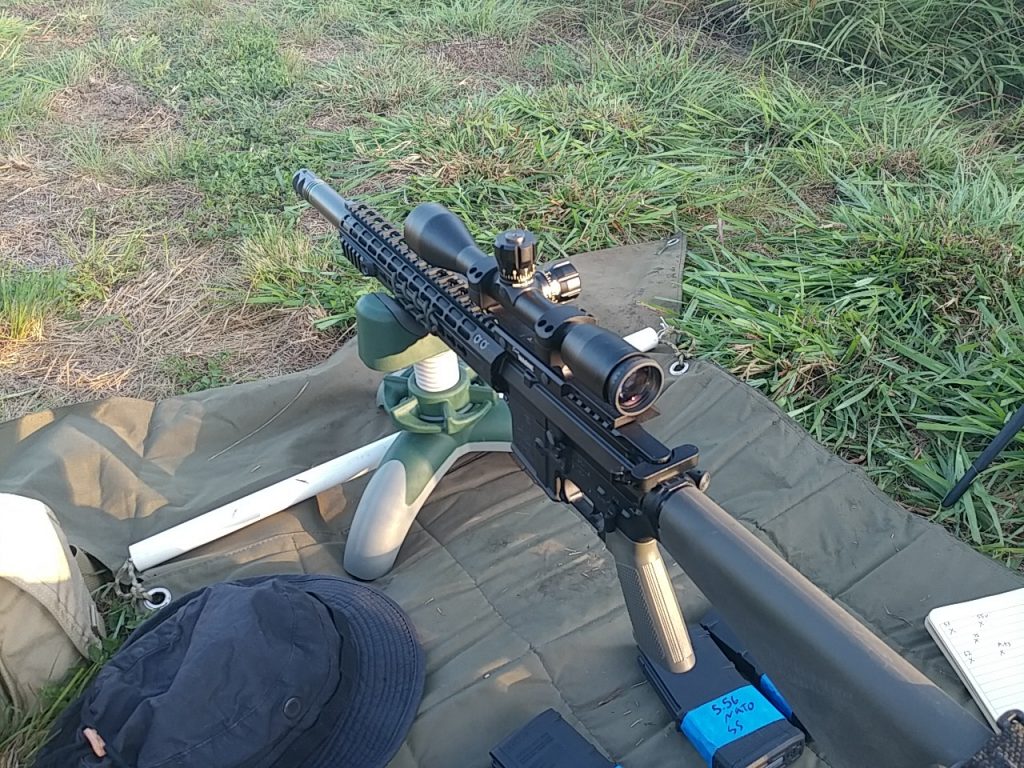
Magazines were pre-loaded and each group shot back to back with no pause to let the rifle cool. First up the Straight Jacket.
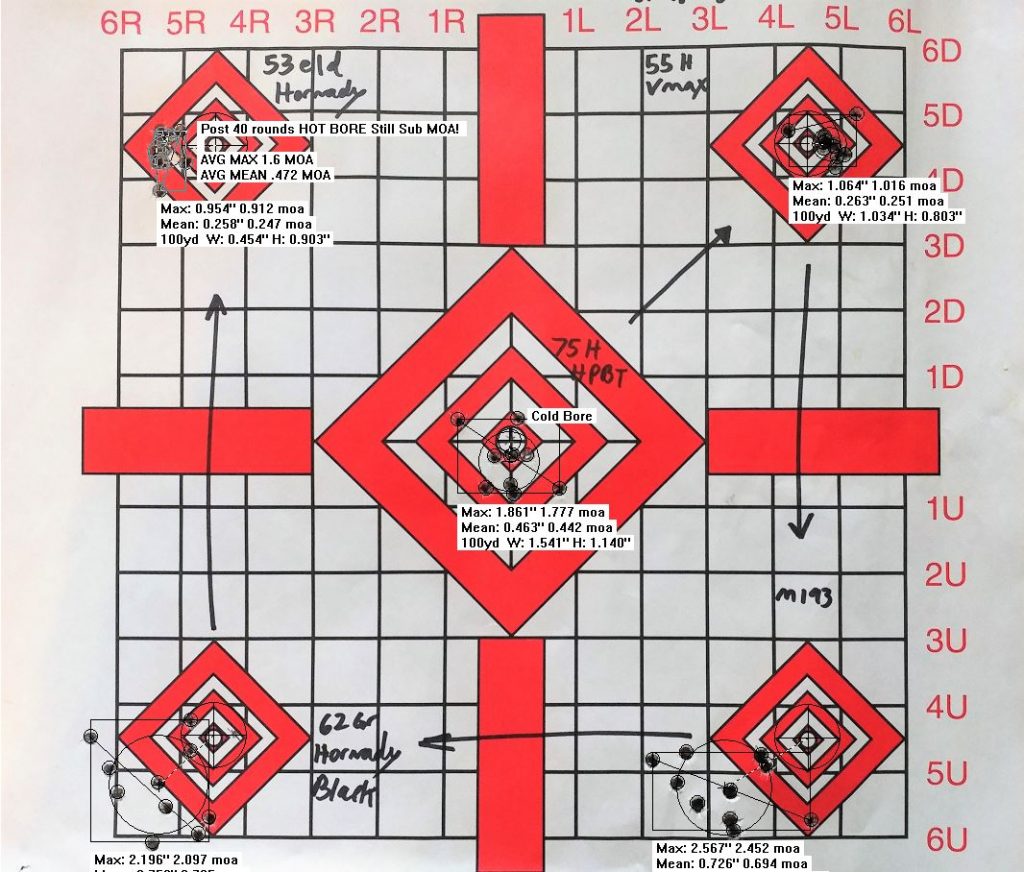
Everything worked here. Shooter and load performance gave us two Sub MOA groups.
Then the control rifle was setup and shot exactly the same way.
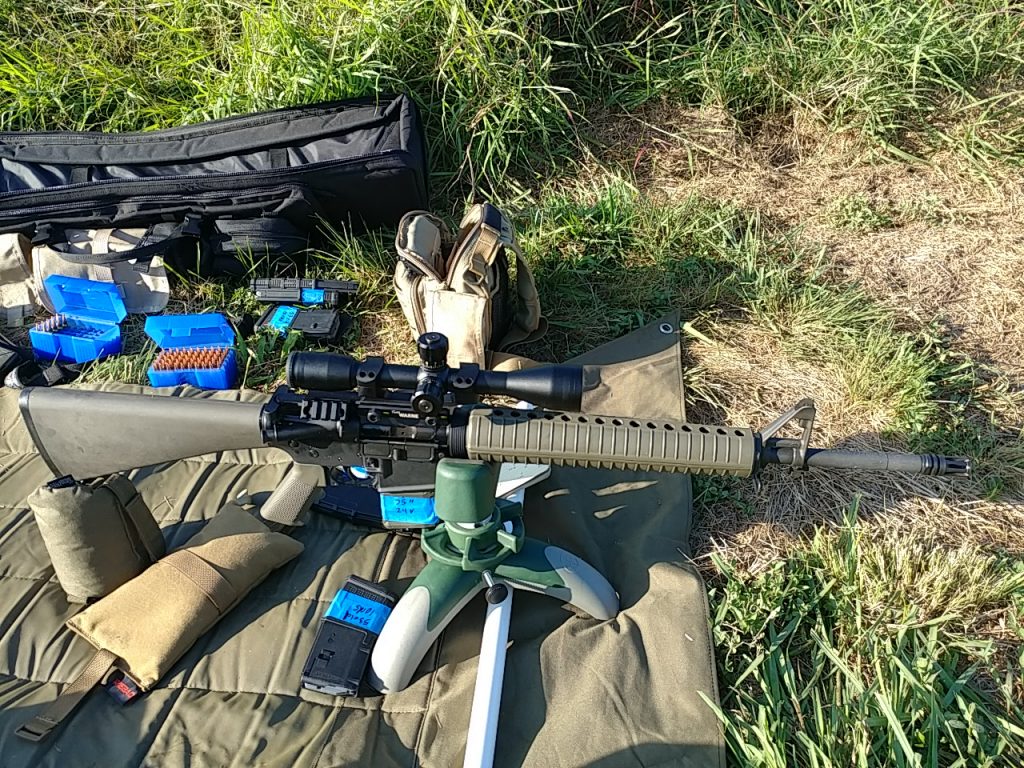
The Colt HBAR was rested off the rearmost portion of the handguards and delta ring to minimize external pressure on the barrel.
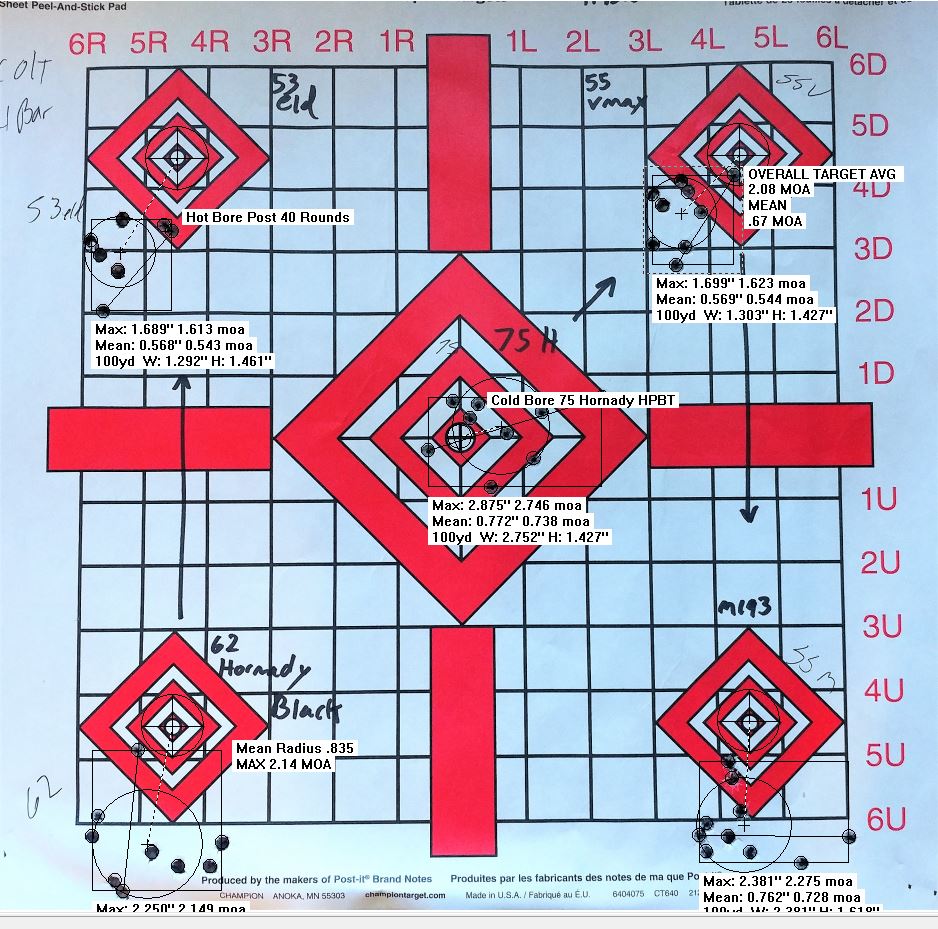
The Colt HBAR faired well, and both barrels shot the mil-spec stuff within error of each other. When the hand loads were thrown in the HBAR couldn’t keep up with the Straight Jacket.
Straight Jacket Average: MAX 1.6 MOA – .472 MOA Mean Radius
Colt HBAR Average: Max 2.14 MOA – .835 MOA Mean Radius
So while not an apples to apples comparison since I still lack a FF tube on the HBAR, we are still able to see that all hand loads shot far more accurately out of the Jacketed Criterion to the point of being no-contest. Over the counter ammo was a wash in performance between the Straight Jacket and HBAR. The Straight Jacket cannot make mediocre ammo better. To get the most out of the Straight Jacket, you need quality ammo.
Weight, Features:
So let’s break down some of the other details of the SJ system. How much does it weigh?
Weight:
I pulled the barrel from the receiver and hooked it to the scale. It weighs 2.8 lbs with permanent gas block attached. Compare this to a 18 inch Criterion HBAR, which is 2.65 lbs without a gas block attached. Very close in weight, but the diameter of the Straight Jacket is much thicker than HBAR profile and it has a bull barrel look without the weight… O.D. is 1.25 inch.
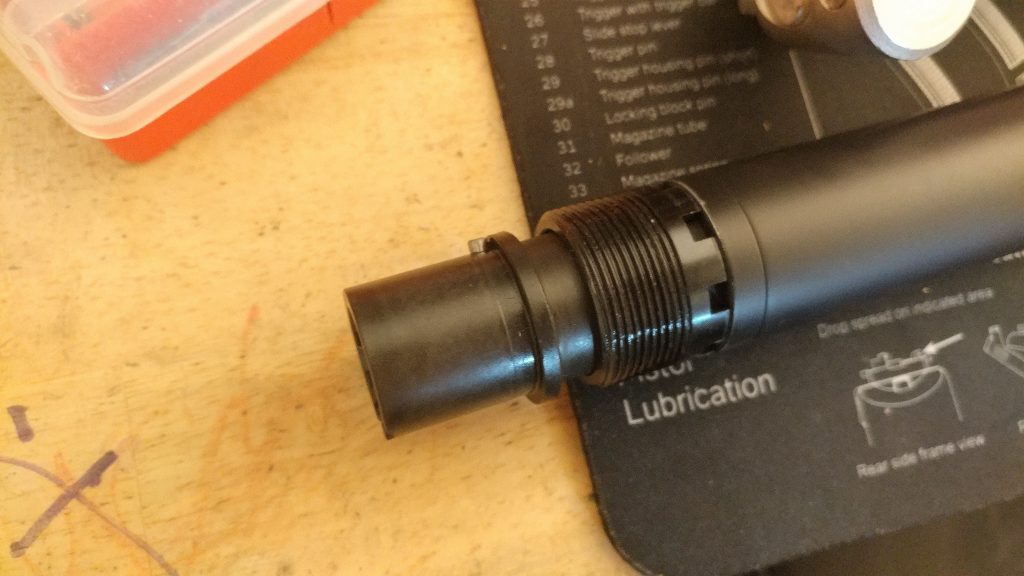
The rear of the barrel and externally threaded barrel nut for the M4E1 system. This is the only area not jacketed aside from the barrel threads. Clean work all around.
Brake:
The included muzzle brake was quite effective… and quite heavy. At .4 lbs this is the heaviest muzzle device I have ever handled. It is a beast. The performance of the device mirrors other high-end muzzle devices I have used in the past. The performance of the brake is powder dependent. When I used Accurate 2230 with a light-weight bullet, the muzzle didn’t move whatsoever. I was able to recall two instances where I could trace the bullet with my eye-catching the shiny rear end of the bullet as it sailed to the target. I haven’t seen a .223 bullet from behind my glass before… especially at only 100 yards.
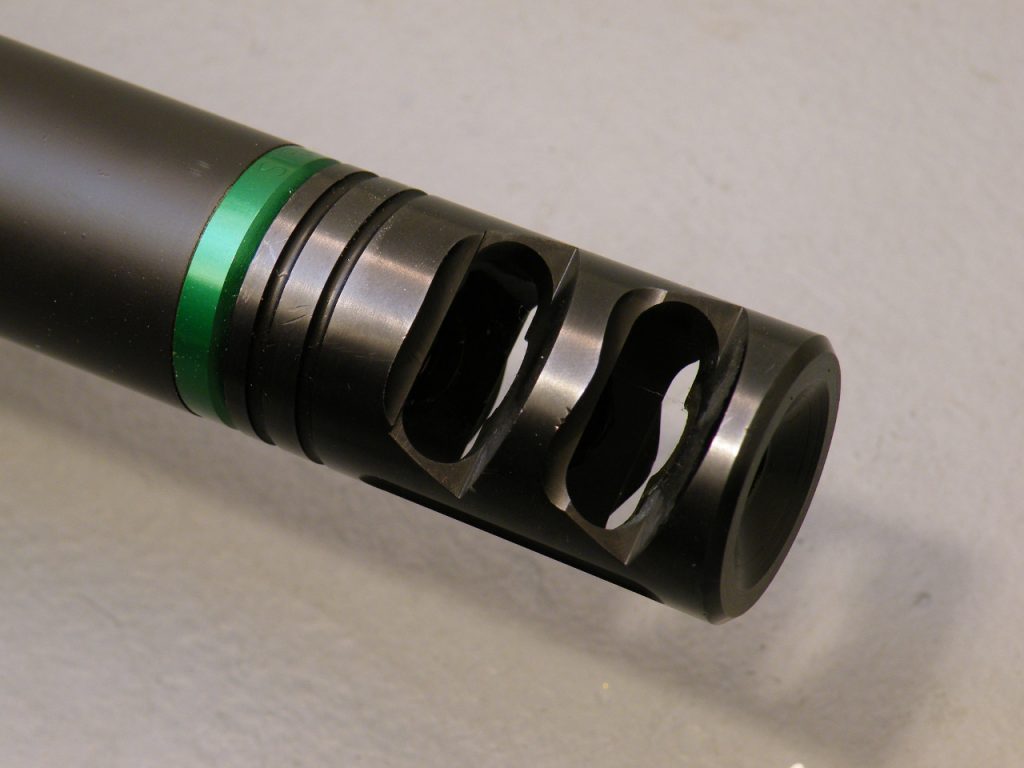
At .4 lbs or 6.4 oz… this is one heavy metal brake. It was quite effective. Could the weight be why we saw a 2 MOA drop after a mag dump?
I reviewed the barrel as is from the factory, but for future reviews I want to install a simple muzzle brake and see what, if any, performance effects it has… particularly at POI shift. I believe it may be a factor in the 2 MOA shift seen after the magazine dump. The factory muzzle device can be omitted for your own brake when ordering a Straight Jacket, but I purchased it since it looked nice and I wanted a factory option. I will replace it with a lighter option to compare the POI shift with the next phase of testing.
Gas Block:

The gas block is user adjustable. I found that shooting it side by side with the colt, the recoil impulse was pleasing from the Straight Jacket so I did not attempt to tune the gas block. The roll pin is a standard roll pin, but the gas tube is a rifle length straight tube. I will inquire if more are available from Teludyne Tech.
Not Quite Done Yet:
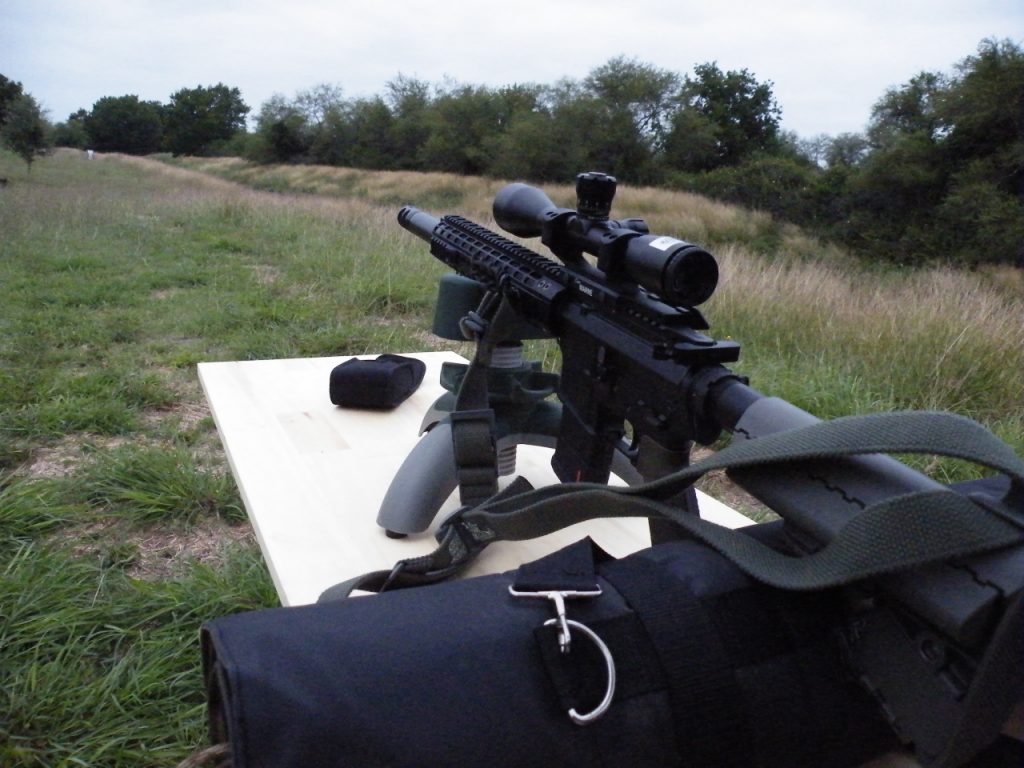
Reliability was 100%. No failures of any kind.
Big shout out to Criterion Barrels Inc and Teludyne Tech. Remember this is a symbiotic relationship. The bore of the Criterion must be pretty damn good to group like it does. The Straight Jacket must be pretty damn stiff to allow the Criterion to keep shooting tiny groups even when it’s hot. I have been back and forth to the range with this system multiple times. I am still working on pushing myself and the Straight Jacket’s performance further. I have only published a small portion of my experience with the Straight Jacket.
We still have to evaluate a few more things. There are many reputable manufacturers who can produce extremely accurate barrels for the AR15, but what sets the Straight Jacket system apart are the other aspects which I was unable to test… namely long-term performance and longevity of the bore. I have seen claims from Teludyne that they have never been able to burn out a Straight Jacket system even with *full auto* magazine after magazine.
Keep in mind that some high level competitors will call a barrel done after 3000 rounds. With the precision the Straight Jacket + Criterion has shown thus far, I would gladly pay the money for a conversion if it meant I never had to re-barrel and thus never have to re-zero / re-work my loads. If the SJ gives a lifetime of accuracy, then once I develop my loads I should never have to worry about pitching a barrel and also pitching everything I have learned about it.
Once I am done with the next phase of testing, the barrel will be pulled and the good folks at Criterion have offered to inspect the bore and give us a report as to how the bore looks compared to other barrels they have on hand.
Summary:
- The Straight Jacket doesn’t turn bad ammo good. Off the shelf ammo shoots similar to a standard HBAR barrel.
- “Out of the box” point of Impact shift was noted with heat. Small POI for slow fire, larger swing in POI for mag dumps.
- Hand-Loads are capable of impressive accuracy through the system. This is the most accurate firearm I own. It’s potential is only limited by the shooter and ammo.
- Group size did not open up from hot to cold bore, just as advertised.
Part 2 To Do List:
Bed the action and re-torque barrel nut to 65 ft lbs (done 9/19/17)
Obtain higher magnification optic
Re-visit my favorite loads with more magnification and re-evaluate POI shift from slow fire to mag dump after bedding barrel.
Free Float Colt HBAR for a slow fire head to head (pending)
Mag Dump O Rama: abuse the barrel and send to Criterion for Evaluation
Intro Article Here which discusses some of the features of the TT Straight Jacket system.
Any tests you would like to see? Comment below!





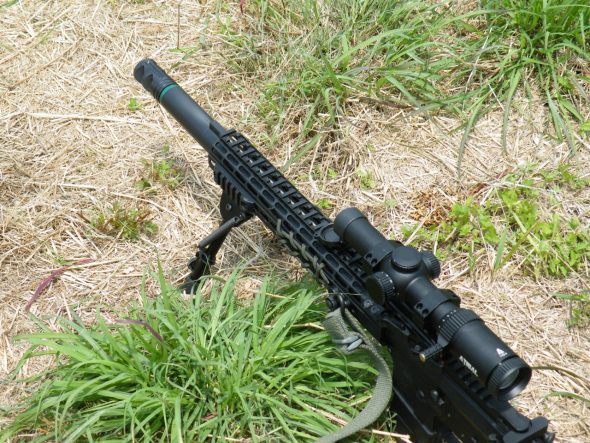



Barrels more accurate than I am? -expensive, but not uncommon.
Barrels that have the same zero across different handloads? Now you have my attention!
From a practical standpoint this seems like a huge waste of cash to be honest. Truthfully the ar15 is more than accurate enough to get the job done in bone stock form.
If you are a casual shooter, I agree your money is best spent elsewhere. A casual shooter’s standard barrel may last them a lifetime.
However if you burn lots of ammo each year and compete, this system might look very attractive if the precision, accuracy, and barrel life are greatly extended over a standard barrel.
In the grand scheme of things, if we run high end 1k optics, spend $240 on triggers, drop $400 on a kreiger, then whats the extra cost of a barrel that has a reported 5x the barrel life?
Its easy to rebarrel an AR, but as I mentioned if I never had to do it again and never had to re-work load data then I would be a happy camper to spend the money.
We will see with the next post how it handles a large volume of fire when the weather cools.
I am quite curious as to how much weight the addition of the straightjacket system adds.
One of the nice things about the Straight Jacket is that it’s actually much lighter than a bull barrel. Depending on what you’re starting with, you may actually save some weight. I’ve got a 6.5 SJ upper for my 308AR build, and it’s actually lighter than the original 308 upper, even though they are the same length barrels, and the 308 is a fluted barrel. It looks heavy, but is deceptively light.
Very good data collecting! It is great to see our products perform without our having any say in what is taking place!
A couple details for this work, the StraightJacket is actually 1.25″ diameter and we have found that the receiver on most ARs tested by us will move “some” with excessive heat build-up. The point of impact shift that holds to our standard is far more difficult to read with a bolt action rifle and is were this claim comes from.
Alan Adolphsen
Teludyne Tech
Thanks for the information and I updated the article with the correct o.d.
We will see if Rock-Set on the receiver extension will reduce the POI some. I had a feeling that the POI shift was not simply the Straight Jacket, hence why I pulled, rock-set, and re-torqued.
Are straight gas tubes available from Teludyne in case my tube blows with the next phase of testing?
Thanks again for the opportunity to test the Straight Jacket system! More to come.
Any updates on your experience following this write-up? Curious how bedding the extension worked for your rifle. Good write-up!
It’s going out today with me, but its a bit gusty so not the best day to test accuracy, but i can still test POI shift. That’s the plan anyway!
Any updates on your findings. I’m really interested in this setup.
Standing by for part 2.
I will be sending the STJ weapon system to someone for a second opinion. Stand by. 🙂